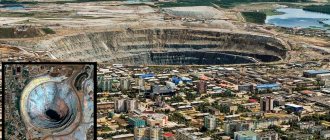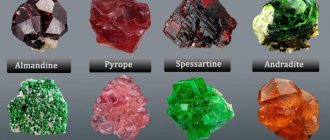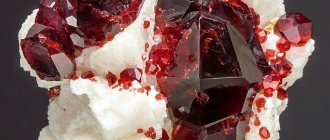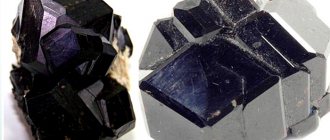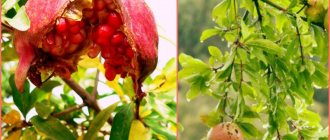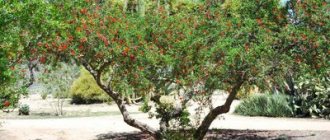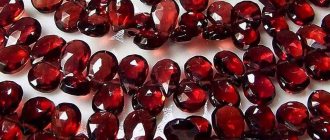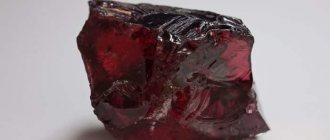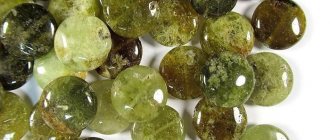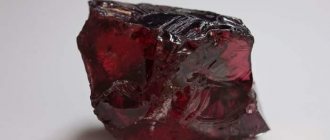Grenades is a large group of minerals (representing mixtures of two isomorphic series) with the general formula R3R2[SiO4]3, where R3= Ca, Mg, Mn, and R2= Al, Fe, Cr.
They are usually found in well-defined isometric crystals (rhombododecahedrons and tetragontrioctahedra or combinations thereof). Sometimes they form continuous granular masses.
Crystals in quartzite. Yakutia
Synonyms: Garnetite - garnetite. Venisa, Garamanticus, Chervets, Yakut (Yagut) are old Russian names. The names of garnets, which in composition occupy an intermediate position between the extreme members of the isomorphic series: ugrandite - between uvarovite, grossular and andradite; grandite - grandite - between grossular and andradite; mangangrandite, manganese grandite - mangan-grandite - between grossular and andradite, contains a small amount of manganese; pyralmandine - pyralmandine, pyralmandite; calcium pyralmandine - calc-pyralmandite - contains a small amount of calcium; pyrandine - between pyrope and almandine; pyralspite - between pyrope, almandine and spessartine; spandite - spandite - between spessartine and andradite (Fermor, 1907); spalmandine - spalmandite - between spessartine and almandine; brandaosite - brandaosite, between spessartine and almandine, also containing Fe3+; gralmandine - gralmandite - between grossular and almandine; magnesia-gralmandite - magnesia-gralmandite - contains an increased amount of magnesium; manganese gralmandite - manganese-gralmandite - contains a large amount of manganese. The names proposed by Vinchel (ugrandite, pyralspite) are widely used in petrographic practice.
Chemical composition
In these minerals, Mg and Fe2+, as well as Fe2+ and Mn2+, replace each other without limit. Isomorphism of Fe 3+, Al, Cr, Ti, Mn3+, V, Y, Ce is widely manifested. Sometimes Si is replaced by Al, less often by Ti and Zr. Characterized by unlimited isomorphism of the molecules grossular and uvarovite, grossular and andradite, almandine and pyrope, almandine and spessartine, pyrope and spessartine, probably uvarovite and andradite. Intermediate members between pyralspites and grandites are rare. Complete miscibility of grossular with spessartine, grossular with almandine or grossular with pyrope is possible only under favorable conditions, which sometimes arise in metamorphic complexes or during synthesis. There are no isomorphic mixtures of pyrope and spessartine. Complete miscibility of andradite and high-titanium shorlomite was noted. The most significant factor determining the existence of isomorphic mixtures in the garnet group is the size of the ionic radii of the cations. The miscibility gap between spessartine and grossular can be explained by the difference in the sizes of Mn2+ and Ca2+ ions, especially in the eight-fold coordination. When studying zoned garnets using an electron microprobe method, differences in the content of Mg, Ca, Mn, Fe, and Si were established in individual zones.
Uvarovite. Brush of small crystals
During crystallization, the mineral is capable of capturing He dissolved in the magma. Earlier minerals contain more He; minerals from pegmatites contain no more than from skarns. In stones from pegmatite veins of Ungursai, 1 g of substance contains 1.60 mm3 He. The mineral from crystalline shales of Upper Svaneti contains 0.002% Li and 0.013% Rb; G. from Kalba pegmatites - 0.05% Rb. Be was found in garnets of Eastern Siberia: from quartz-spodumene pegmatites - 0.0002-0.0003%, from quartz-albite - 0.0001-0.0008%; Sc is typical for garnets from shales (probably replaces Mg or Fe2+), and is found in garnets from syenites and pegmatites of the Eletyozersky massif in Karelia (0.0019-0.0027% Sc). Small amounts of Mn 3+ were found in some minerals of the group; Ga (0.0455%) is found in garnet from Kalba pegmatites, Ge (0.0029–0.0066%) is found in hydrothermal garnet. In essentially calcium garnets, Ca is replaced by strontium; Zn is found in garnets rich in Mn, Fe, Mg (replaces Fe2+); Sn was determined in G. from syenite of the Arga-Yuryakh intrusion in Yakutia (0.0184%), from the skarn-magnetite deposit Myshikkol in the Kuraminsky ridge (0.2%), and from quartz-mica hornfels of Uzbekistan (0.13% SnO,) . For a stone containing a small amount of tin, the insufficiently substantiated name dhanrasite was proposed (Marty, 1967). The highest content of rare earths is characteristic of spessartine (spessartine from Kanozero on the Kola Peninsula contains 3.05% TR2O3); spessartines are characterized by the presence of yttrium (up to 2%), which is less common in essentially magnesian garnets. Andradite from granitic pegmatites of Gatineau Park in Quebec (Canada) contains 0.75–2.65% Y. Almandine from Schreiberhau in the USA (2.64% TR2O3) also stands out for its high content of rare earths. G. are known containing 0.001% Nb2O8; 0.0004% Ti was found in gGyu from Sayan pegmatite.
The uranium content in them varies within the range of 10-8-10-5 g/m, higher concentrations are typical for essentially calcium garnets confined to alkaline rocks. The trace elements of some garnets include K, Na, P. In minerals from granites, pegmatites, greisen and quartz veins, the manganese component predominates, and the trace elements are Ti, Y, Sc, Ge, Ga, Be, Sn, Zr. The most characteristic of skarns is essentially calcium; trace elements of such minerals are in sulfide skarns - Ti, Ge, Sn, As, Pb, Cu, V, in iron ore skarns - Ti, Cr, V, Ni, Co, Zr, Y, Sc. These same elements are found in garnets from amphibolites, gneisses and metamorphosed basic rocks. In spessartine-almandines, Y, Sc, Ge, Ga, Be are common, in grossular andradites - Y, Cr, Ni and Cu.
According to Ford, one sixth of all analyzed garnets is composed of molecules of the two extreme members of isomorphic series, i.e., two endgames, and contains no more than 5% of other endamels; one sixth contains four minals and the remaining two thirds - three minals. Boeke constructed diagrams showing the limits of isomorphism for various garnet endgames; he indicated the limits of isomorphic substitutions for oxide groups; Herich provided similar data for each oxide separately. Ford constructed three-component diagrams that make it possible to determine the composition of gas by density and refractive index. Philipsborn came to the conclusion that in order to determine the composition of hydrogen, it is necessary to know the density, refractive index, and weight content (%) of the oxide of a divalent cation (preferably Ca) or the density, refractive index, and weight content (%) of two oxides of divalent cations. Stokwell pointed out the additive relationship between the composition and the unit cell size, which makes it possible to judge the predominant component of garnet by the intensity of the powdergram lines. Fritsch noted the possibility of determining the composition of hydrogen by the size of the unit cell and the refractive index. Diagrams of the dependence of the refractive index and unit cell size on composition have also been proposed by other authors.
The chemical composition depends on the type of host rock. Based on the relationship between the chemical composition of garnets and the nature of the host rocks, Tröger identified 28, and Sobolev identified 37 paragenetic types of garnets. In the petrographic literature, “iron content” is used to compare iron-bearing garnets—the ratio FeO:FeO+MgO (in %). The most ferruginous minerals (75–79%) are found in the gneisses of Canada, the USA, and Finland. In the same rocks, the iron content of garnets can fluctuate. Thus, in garnets from gneisses it varies from 58 to 79%, which is associated with different formation conditions, primarily the pressure. The iron content of garnets increases from high-temperature ceramic pegmatites to lower-temperature rare metals. Their ferruginous content is interrelated with the ferruginous content of coexisting minerals. The iron content of artificial garnets of the andradite - grossular series depends on the acidity - alkalinity of the medium; Gels with a high content of the andradite component were obtained in alkaline media, and those with a high content of the grossular component were obtained in acidic media. In association with cordierite, iron can be stable in a fairly wide range of iron content (20-25%)—within the almandine-pyrope composition. The study of geothermal association with cordierite is important for determining the P-T conditions for the formation of metamorphic rocks and the depth of their formation. The compositions of gas and the associated cordierite of many metamorphic provinces are similar, which indicates similar conditions of metamorphism. The composition of garnet and the concentration of certain elements in it depend on the mineral association in which it is found.
Grossular. Crystal intergrowth. Mexico, Jaco
Varieties of pomegranates
In nature, only intermediate members of isomorphic series are found; extreme members obtained artificially are distinguished under the following names:
1) Aluminum:
Pyrope Mg3Al2[SiO3]4 - dark red; Grossular Ca3Al2[SiO4]3 - light green, greenish-brown, yellow Spessartine Mn3Al2[SiO4]3 - pink; Almandine Fe3Al2[SiO4]3 is the most common of garnets, the color is pale red-lilac, crimson;
2) Zirconium: Kimzeite Ca3Zr2[Al2SiO2] 12.46 4.0 3) Vanadium:
goldmanite Ca3V2[SiO4]3 yamatoite Mn3V2[SiO4]3 4) Chrome
knorringite Mg3Cr2[SiO4]3 uvarovite Ca3Cr2[SiO4]3 - emerald green; 5) Ferrous majorite Mg3(Fe,Si)2[SiO4]3 andradite Ca3Fe2[SiO4]3 - dark red-brown, to black titanium - varieties of andradite (melanite and sherlomite - pitch-black.
Crystallographic characteristics
Syngony. Cubic. 3L44L36L29PC
Symmetry class. Hexahedral Oh—m3m
Crystal structure
For the first time, the structure of G. was studied by Mentzer using the example of grossular. Recently, the structure has been refined in the study of grossular and pyrope. The lattice is body-centered. The structure is based on isolated silicon-oxygen tetrahedra and oxygen octahedra with trivalent metals. Divalent metals are located in the cavities of a framework of tetrahedra and octahedra and are surrounded by eight O atoms. Each oxygen atom in the structure is associated with a Si atom, one trivalent and two divalent atoms. On the block selected for simplicity of the image, which represents 1/64 of the unit cell of the grossular, Al atoms occupy the vertices, Si and Ca atoms occupy the middle of the edges. The Ca atoms, each surrounded by eight oxygens, form polyhedra in the form of Thomson "twisted" cubes. Oxygen atoms occupy the vertices of octahedra (with Al inside in the grossular); the octahedra are connected by triangular prisms, on the lateral square faces of which Ca atoms are located; infinite columns of prisms and octahedra are extended along non-intersecting triple axes. These columns are parallel to the diagonals of the cube with mutual angles of 70°30′ and are connected by “twisted” cubes (with Ca inside) and isolated silicon-oxygen tetrahedra. When clarifying the structure of G., it turned out that its polyhedra are distorted: silicon-oxygen tetrahedra are tetragonal bisphenoids elongated along 4th order axes; The Al octahedron is a trigonal antiprism elongated along the 3rd order axis; Ca(Mg)-ky6 is distorted so that the angles between its faces in pyrope range from 76 to 119°. According to Abrahams and Gehler, the distortion of Ca-polyhedra in uvarovite is less than in grossular, and in andradite the polyhedra are distorted even less, or only the tetrahedra are distorted. In pyrope, the distortion of polyhedra is as strong as in grossular. The energy of the crystal lattice was considered using the example of pyrope and grossular. Natural or synthetic products with a G structure are known for 40 elements. The position of individual cations in the structure was considered by Gehler [18]. Among artificial compounds with a gas structure, substances are known whose octahedral positions include: Ca, V, In, Sc, Al, Fe, Cr, Mg, Mn2+, Mn3+, Rh, Co2+, Ni2+, Cu 2+, Zr, Ti; Ca in garnets can be replaced by Mg, Fe, Cd, Ba, Sr, Th, Zr, Ge, Mn2+, TR from Gd to Lu; TR from Tb to Lu are included in the composition of gas in combination with Al (Lu3Al5O12), from Nd to Lu and Y - in combination with Ga (Lu3Ga5O12) or with Fe3+, which replaces Si; Si is replaced by Ge, Ga, Fe, Ti, Zr. Among the minerals isostructural with garnets: berzelyite - (Ca, Na)3 (Mg, Mn)2 (AsO4)3, griffite - (Mn, Na, Ca)3 (Al, Mn)2 [PO3 (OH, F)] 3 and cryolithionite—Na3Al2 (LiF4)3.
Main forms: the most characteristic and most common form is d(110), as an independent form n (211) is often found. Less commonly observed forms are: a(100), o(111), e(210), r(332) and s(321).
Tetragontrioctahedron.Almandine crystal
Interesting facts about pomegranate:
- Bright red garnets were called “carbuncles” in ancient times. In Rus' they were known as “worm-shaped yachts”. Very often, “garnet” refers to the red subspecies of this family, and green stones are called “olives.”
- Pomegranate is a good talisman for those involved in risky activities. It protects travelers on dangerous roads. The ancient Romans considered it an indispensable amulet during pregnancy. And in the Middle Ages they believed that using a stone could stop bleeding and protect against wounds. The Crusaders valued rings with almandines, and talismans with engraved lions were supposed to heal all diseases.
- The poet Goethe's muse Ulrika had jewelry made from Bohemian garnet. Their set consisted of 500 stones painted deep red, and today it is kept in the Bohemian Museum.
Form of pomegranate in nature
Crystal Appearance
The faces of G. crystals are in order of decreasing prevalence, according to Shafranovsky: (110), (211), (321), according to Donay-Harker: (211), (110), (321), (100). Distorted crystals are often observed. Uneven development leads to the formation of flattened, predominantly along (111), bipyramidal and lenticular crystals, elongated along a four-fold axis. The d(110) faces are often streaked parallel to the long diagonal. On the (211) faces, hatching parallel to the (211) : (110) edge was observed, and on some faces there were growth steps or etching figures. The nature of the growth stages differs among garnets of different origins. Garnets with a stepped (imbrella) surface are found in sedimentary rocks. On crystals of uvarovite, andradite and grossular, d(110) is more often observed; pyrope, almandine and spessartine are characterized by n(211). The appearance of crystals may depend on the geological conditions of mineral formation. The development of individual faces on garnet crystals presumably depends on changes in the relative concentrations of R2+ and R8+ in solutions: with an increase in the concentration of R3+, the (211) faces predominantly develop on the crystals, and with a relative excess of R2+, the (110) faces develop. On G. crystals from the Lyangar deposit (Uzbekistan), a change in shape (110) in the core to (211) in the outer faceting was observed. Inverse relationships were noted for G. with the river. Akhtaranda in Siberia.
Grossular. Tetragontrioctahedral crystals. Yakutia, Mirny
Doubles. The crystal structure of garnets excludes the existence of twins. The (111) twins described by Kobel and Artsruni and Hedl are probably intergrowths.
STRUCTURE
Crystal structure of garnet
Cubic system, hexoctahedral type of symmetry. The structure of garnets consists of isolated groups (Si04) located along a fourth-order helical axis. This explains the rhombododecahedral and tetragontrioctahedral habit of the crystals, and the change in the ratio between divalent and trivalent cations may apparently be responsible for the predominance of the rhombododecahedral appearance for the calcium series of garnets, and the tetragontrioctahedral one for the aluminum series. Based on the nature of isomorphic substitutions, the following are distinguished: I. (Mg, Fe, Mn) AI-garnets, called pyralspites; II. (Al, Fe, Cr) Ca-garnets, called ugrandites. Continuous series have been established: pyrope – almandine, almandine – spessartine, grossular – andradite and andradite – uvarovite. There is no complete isomorphic miscibility between Al-garnets and Ca-garnets.
Mineral inclusions
Inclusions of other minerals are often observed in garnets: vesuvianite, calcite, quartz, magnetite, epidote, diopside, chlorite, biotite, feldspars, pyroxenes, muscovite, amphibole, titanite, kyanite, staurolite, apatite, zircon, rutile, etc. Sometimes G. is only a crust or perimorphosis surrounding a core, which is composed of other minerals; Such case-shaped crystals have been found in skarns. Some inclusions of minerals in metamorphic rocks have the appearance of smooth S-shaped curved stripes (the so-called “snowball” structures), which indicate simultaneous crystallization under mobile conditions. In garnet lorphyroblasts, inclusions differ in the time of formation. The presence of gas-liquid inclusions was noted. Its regular intergrowths with various minerals were observed: (211) garnet parallel to (001) muscovite], (110) and (001) gG. parallel to (001) and [100] muscovite; [110] garnet parallel to rutile extension; (211) garnet parallel to (0001) corundum; (211) and [011] garnet parallel to (010) and [001] topaz. Intergrowths of pyrope with diamond are known. Regular intergrowths of garnet and orthoclase were observed: face (110) rG. almost parallel to (001) orthoclase; intergrowth of garnet with quartz (in pegmatite veins of the Dzirul massif and the Southern Urals). Skeletal intergrowths of garnet with bytownite are described (written structure).
Aggregates.
What types of grenades are there?
Garnet stones come in many varieties. They differ in structure and places of extraction. Garnet colors also vary.
Pyrope
The name of this mineral is translated from Greek as “like fire.” It is related to the color of the stone. It can be purple or deep scarlet. Such shades are associated with the presence of magnesium and aluminum in the mineral.
Rhodolite
This term refers to the combination of pyrope and almandine. This stone contains a lot of iron. It is characterized by different shades - pink and purple. In more rare cases, the mineral is red.
Almandine
The main difference between almandine and pyrope is its lighter red hue. It is associated with the presence of potassium and magnesium impurities in the composition. The color and color saturation depend on their volume. The stones are purple, pink, brownish or red.
Andradite
This mineral is characterized by many shades - yellow, greenish, brown, brown. In more rare cases, red gems are found.
Grossular
It is often called gooseberry. The name is due to the external resemblance to this berry. The stone can have different shades of green or a yellowish tint. Its color is determined by its chemical composition. It is an alumina-calcium silicate, which contains iron ore impurities.
Mineralogists identify another variety of this mineral - hydrogrossular. It is characterized by a shade of sea wave.
Physical properties of garnet
Optical
The color is often red, brown, yellow, green, black; colorless ones are rare. The color of brown tones of calcium garnets of the grossular-andradite series can be caused by ferric ions in six-fold coordination; Calcium-free garnets—almandines, pyropes, and spessartines—are characterized by predominantly red tones; coloring can be caused by iron and manganese ions, as well as chromium and titanium. The color of almandine is caused by Fe and Mn ions in octahedral coordination or Fe ions in “twisted” cubes. The color of pyropes is explained by the isomorphic admixture of Fe and Mn, which can be included in “twisted” polyhedra or octahedra; Cr and Ti can also affect color. The color of spessartines is probably caused by Mn2+ and Mn3+ in six-fold coordination, Fe2+ in eight-fold coordination, and Fe3+ in six-fold coordination. The green color of uvarovite and demantoid is caused by chromium. With a small content of chromium, which replaces aluminum, the color is red; with a higher Cr content, the size of the octahedron changes and the color becomes green. In uvarovite, in contrast to pyrope, Al and Mg are replaced by Cr and Ca, which leads to a shift of broad absorption bands to the red region of the spectrum.
The line is missing. The color of the powder is white or light shades.
The luster is glassy, sometimes close to diamond or diamond-like.
G. with muscovite in quartz. Karelia
The ebb is greasy, resinous,
Transparency. Transparent to varying degrees to opaque.
Mechanical
Hardness 6-7.5. Fragile
Density 3.18-4.28, depends on the composition. In andradites, the density increases proportionally with increasing Fe2O3 content.
Cleavage is usually absent; sometimes there is imperfect cleavage or separation along (110).
The fracture is semi-conchoidal, uneven or splintered. They break into fragments with sharp edges.
They are fragile, crumbly in granular aggregates, but very strong in dense (cryptocrystalline) masses.
Garnet and zodiac sign
Instances of red, orange and purple colors are suitable for all representatives of the element of Fire, as well as Capricorns and Aquarius.
Dark garnets become good helpers for Capricorns and Scorpios. Green gems are recommended for Libra, Sagittarius and Capricorn. There are no contraindications for using jewelry with garnets for other zodiac signs.
Chemical properties
With brown and phosphorus salts, many of them react with Fe and Mn; with phosphorus salts they form a silica skeleton. They react weakly with HCl, with the exception of demantoid. When exposed to HCl (for several hours), different acid resistance of minerals of this group was noted; it increases in the direction andradite - pyrope - grossular. After calcination, HCl easily decomposes, releasing gelatinous silica. They decompose when fused with Na2CO3 or K2CO3.
Other properties
Brush crystals on a fine-grained aggregate.
The magnetic susceptibility of iron-magnesium garnets is proportional to the iron content. Artificially produced minerals with iron in the octahedral and tetrahedral positions are ferromagnetic. Y3Fe2[FeO4]3 has especially strong ferromagnetic properties; in this compound all iron is trivalent; the magnetic moment is 2/3 of the magnetic moment of magnetite, the Curie point is 545° K. Y3Fe2 [FeO4]3 single crystals have a fine domain structure. The elasticity coefficient increases with increasing temperature. In the infrared absorption spectra, individual bands shift to low frequencies as the cation radius increases. All of them are characterized by three main absorption bands: the position of the band 1142-1003 cm-1 does not depend on the composition; the position of the bands 1006-775 and 927-786 cm-1 depends on the composition (for garnets of the pyralspite series 1006-951 and 927-868 cm-1, for garnets of the grossular-andradite series 927-882 and 868-786 cm-1). In the region of 350-280 cm-1, the pyralspite series gives weak absorption bands that are absent in garnets of the grandite series. In addition, three absorption bands were observed at 4500, 6000 and 7800 cm-1, due to the presence of Fe2+ in eight-fold coordination. In the ultraviolet region of the spectrum they give a number of narrow maxima; All of them are characterized by a maximum of about 22,700–22,800 cm-1. In the andradite-shorlomite series, absorption is directly dependent on the titanium content in quaternary coordination.
The average temperature of decripitation from various deposits: grossular - 393°, uvarovite - 440°, andradite - 487°, almandine - 607°, pyrope - 615°, spessartine - 646°.
Diagnostic signs
Easily recognized by their isometric crystals, high hardness, and lack of cleavage.
Satellites. Diopside, hedenbergite, epidote, vesuvianite, wollastonite, actinolite, chlorite, hedenbergite.
Use of stone in medicine
The healing properties of the mineral have been known since time immemorial. Among our ancestors, the stone had extremely positive characteristics and was used for the treatment and prevention of many diseases. Before campaigns, medieval crusading knights always put a ring on their finger, into which a red garnet was inserted. They believed that the decoration would protect them from serious illnesses and injuries, and after completing the campaign, it would help them return home unharmed. The Slavs considered pomegranate the patron saint of women in labor. The stone was left at the head of the woman’s bed so that she would quickly and safely be relieved of her burden. In India, the mineral has been used for thousands of years as a general tonic. According to the residents of this country, it has the power to restore a person’s immunity and protect him from all kinds of ailments.
Beneficial properties and contraindications, or rather the lack thereof, have made pomegranate one of the most popular healing minerals today. For diseases of the respiratory system (bronchitis, pneumonia, pleurisy), representatives of alternative medicine recommend wearing a silver jewelry with garnet crystals around the neck. A gold ring with a red mineral placed on the middle finger of your right hand will help you get rid of migraines and cure a sore throat. A blue garnet in a silver frame will help lower body temperature during a cold or viral disease. For this purpose, it is best to use a ring or bracelet.
Gold bracelet with garnet (go to the SUNLIGHT catalog)
In addition to the cases of the listed ailments, garnet jewelry is recommended to be worn for gastrointestinal, endocrine and dermatological diseases. The stone will help with allergic reactions, stress and depression. It has the ability to quickly heal wounds and restore the body after illnesses.
Origin and location
They are among the most important rock-forming minerals. They are formed in a wide range of temperatures and pressures and in various environments. They participate in the formation of many mineral deposits. Pyrope is a typomorphic mineral—a companion of diamond in kimberlites. They are observed in some igneous rocks as their primary component (in basic rocks - pyrope, in granites - spessartine and almandine, in alkaline rocks - melanite and shorlomite). Spessartine is most common in pegmatites; Some of them showed garnetization of plagioclases. Garnets of later generations are characterized by an increase in the andradite component. The dependence of the composition of garnets from pegmatites on the physicochemical conditions of their formation was noted.
Almandine. Crystals in gneiss.
The most widespread are contact-metasomatic formations, mainly resulting from the interaction of acidic magmas with carbonate rocks. Grossular and andradite are especially characteristic of such formations. They are found in the form of continuous masses or are included in skarns along with diopside, hedenbergite, epidote, vesuvianite, wollastonite, actinolite, chlorite, etc. Different skarns differ in composition. Thus, in skarn lead-zinc and copper-iron ore deposits, andradite occurs (in association with salite); in skarn scheelite and molybdenite-scheelite deposits, substantially grossular gemstone is found (in association with hedenbergite). When acidic magmas acted on basic metamorphic rocks, almandine was formed along with biotite, hornblende, feldspars, sometimes with pyroxenes, tourmaline, sulfides, etc. Quite often they are found in crystalline schists ; the composition depends on the composition of the source rocks; if the source rocks are rich in Al and Fe, almandine is formed; during the metamorphism of calcareous rocks, grossular is formed; high Mg and Al content is favorable for the appearance of pyrope. Pyrope-almandine-spessartine rocks (pyralspites) are characteristic of three facies of metamorphism that are adjacent in thermodynamic conditions: amphibolite, granulite, and eclogite. Spessartine is typical for the amphibolite facies; almandine predominates in the granulite facies (it can contain up to 45% of the pyrope component and up to 23% of the grossular component); in the eclogite facies, there is a pyrope-almandine component (G., associated with kyanite, contains a significant amount of the grossular component). Accordingly, it is recognized that with an increase in the degree of metamorphism, the content of the pyrope component increases and the content of the spossartine component decreases. When studying the MgSiO3—CaSiO3—Al2O3 system, the enrichment of the pyrope component, coexisting with clinopyroxene and orthopyroxene, was confirmed with an increase in pressure to 70 kbar at a constant temperature, as well as with a decrease in temperature at a constant pressure. The pyrope content ranges from 81 mol. % at 18 kbar to 88 mol. % at 71 kbar and 1400°. Under conditions of polymetamorphism (diaphthoresis), the composition changes depending on the degree of change in rocks and temperature. During low-temperature diaphthoresis, the composition does not change; it is replaced only by a fine-scaled aggregate of sericite and chlorite. The manganese content of garnet, in addition to thermodynamic conditions, depends on the manganese content in the original rock. Miashiro's statement about the decrease in the content of the spessartine molecule with increasing pressure is unreliable. With an increase in the degree of metamorphism, the molecular volume and a0 of garnets decrease, Ca2+ and Mn2+ are replaced by smaller Fe2+ and Mg2+ and, apparently, the ratio (CaO+MnO) : (FeO+MgO) is an indicator of the degree of metamorphism. According to other authors, such an indicator is the Mg/(Mg+Fe) ratio. G.'s associations include biotite and GG. - hornblende, the distribution of Fe and Mg depends on the degree of metamorphism. In staurolite-garnet schists, the distribution of Mg in staurolite and garnet can serve as a temperature indicator. In coexisting biotite and garnet, with increasing temperature, Al2O3 passes from biotite to garnet, and Fe2O3 from garnet to biotite. In metamorphic rocks, progressive recrystallization sometimes produces very large crystals.
Products
Jewelry quality garnet is usually worn in silver. Slightly less often, transparent examples of the stone are worn in a gold frame. The opaque mineral is good for stylish youth items made of copper and other jewelry alloys. Also popular are beads, bracelets, necklaces, brooches, pendants and pendants. For men, rings and cufflinks are created, lighters are encrusted, and the male zodiac stone is convenient to have with you in the form of a cabochon.
Photo of garnet stone
The mineral looks simply wonderful! Jewelry with this crystal looks no worse than with ruby and diamond. Garnet rock looks no less attractive! No description of a pomegranate can compare with a photograph, so behold!
Pomegranate
Garnet is the love stone of Capricorn
Pomegranate
Pomegranate
Ring with garnet, Regor2005, flickr.com
Pomegranate, Václav Paveza, flickr.com
Garnet, Didier Kobi, flickr.com
Garnet, Stan Celestian, flickr.com
Necklace with coral and garnet, bartolo garrido, flickr.com
Earrings with garnet, onesimo cordova, flickr.com
Pomegranate
Pomegranate
Ring with red garnet
Cut, photo: mike fiedler, flickr.com
Pomegranate amulet
Garnet, Stan Celestian, flickr.com
How to wear and care
If you wear a gem for healing purposes, the stone should be in contact with the body. Contact with the mineral enhances interaction with the human biofield.
Men are advised to carry the stone with them in the form of personal items inlaid with garnets, such as keychains, cufflinks, window rings, or carry a small cabochon in their pocket.
To care for the stone, you need to clean the garnet from accumulated dust and dirt by wiping it once a week with a napkin: be it velor or paper, don’t be afraid to scratch the crystal. It is also recommended to wash the product with warm soapy water and then rinse it from the tap.
How much does a garnet stone cost?
Let's give some examples of prices. How much a natural garnet stone costs in rubles mainly depends on the weight and quality of the mineral. The price for rings with a small stone of about 1 carat and a crystal diameter of about 5 mm starts from $25 (1600 in rubles). The price for an exclusive ring with a huge faceted stone insert of 20-25 mm can reach up to $500 (more than 30 thousand rubles).
Stones in the form of druses are also sold for interior decoration or for collection - a small sample up to 3 cm in size can be obtained for $28 (1,800 rubles).
You can get a small opaque unprocessed pebble up to 1.5 cm for 10-15 dollars or 600-960 rubles. A 3 cm druse made of rare natural green tsavorite garnet and vanadium grossular can cost $160 or 10 thousand rubles.
Silver men's cufflinks with 5-mm almandines of a representative appearance will cost $170 (about 10-11 thousand rubles).
Collectors typically purchase low-quality, unprocessed mineral or rock specimens. You can afford a stone from the widest assortment out of your pocket from 10 to 160 dollars (600-10,000 rubles).
Individual antique jewelry with garnet can be so expensive that if you write down the estimated price, you most likely won’t even get into the number of zeros.
Mineral Change
Secondary minerals formed from garnets include: epidote, micas, hornblende, scapolite, orthoclase, calcite, quartz, chlorites, serpentine, dolomite, magnetite, hematite, cordierite, sillimanite. When weathered, they are difficult to destroy, with the formation of clay minerals. Hydrogens make up a significant part of the heavy fractions of a number of sedimentary rocks.
Crystals. Karelia
Talismans and amulets
The protective power of pomegranate has been known since ancient times. Land travelers and seafarers often took with them a ring or pendant with a garnet stone, as they believed that it would protect them from all sorts of troubles along the way. Knights, going on the Crusade, always wore a ring with a garnet so that it would protect them from injury and death in battle. The stone is also considered a powerful love amulet, so young girls of past centuries carried a small gem with them almost from birth in order to marry successfully and out of love.
Talismans with pomegranate are still popular today. Everyone buys them for the same reasons:
- Travelers and people whose activities involve frequent travel in order not to go astray and avoid dangers.
- People of military professions and representatives of law enforcement agencies to protect their own lives.
- Politicians and businessmen to more easily achieve their goals.
A person can gain the protection of a pomegranate if he has good intentions, is honest and benevolent. Otherwise, the stone will not help, and may even destroy all plans.
- People of creative professions, so as not to lose inspiration and create, create, create.
- Young girls to experience unearthly love and get married as soon as possible.
- Family people to maintain the fidelity of their spouse and rekindle the extinguished flame of passion.
The pomegranate most strongly patronizes men named Anton, Nikita and Vasily, and women named Alexandra and Alla, Valeria and Galina, Lyudmila, Maria and Tamara.
Practical use
The described group of high-hardness minerals (almandine, pyrope, spessartine, and to a lesser extent andradite) are used as an abrasive material. Rocks containing more than 10% of well-formed large crystals (more than 1 cm) are considered suitable for the abrasive industry. They are floated with Na oleate (pH 11.5 and higher), distilled tall oil soap, oxidized petrolatum (pH 3.5); 90% of the mined mineral is used to make paper or cloth for polishing hardwood, polishing mirror glass, polishing leather, hard rubber, celluloid and other products. Transparent and beautifully colored minerals of the group (hessonite, pyrope, grossular, uvarovite, almandine, demantoid) have long been used in jewelry. In connection with their use as ferrimagnets, numerous works on their synthesis, especially rare earth ones, appeared.
How to distinguish an original from a fake
Despite the relatively low cost of the mineral, it can also be counterfeited. The synthesis of garnet began in the first half of the twentieth century. At first, artificial stones were used in industry.
High-quality synthetic stone costs the same as natural stone. Sometimes its cost even exceeds its natural counterpart. The advantage of synthetic stone is the variety of colors that do not exist in nature.
At the same time, it can be quite difficult to distinguish a natural pomegranate from an artificial one. They are very similar in characteristics. However, there are some features that you can consider when purchasing:
- To identify a fake, rub the product on a woolen cloth. The natural mineral becomes electrified and will attract light particles. This will not happen with artificial stone.
- Synthetic fakes are characterized by bright, unnatural shades. It also has a uniform color.
- Stones that are larger than a coffee bean are artificial. It is impossible to find such large grenades under natural conditions.
- The natural mineral is much harder than colored glass.
- Natural stones have poor thermal conductivity. If the jewelry quickly heats up in your hands, it is most likely fake.
Garnet is a popular stone that has pronounced healing and magical properties. This mineral is very popular among many people. It allows you to create beautiful images and attract good luck to your life.
Crystal optical properties in thin preparations (sections)
In thin sections, andradite, grossular and spessartine are colorless or colored pinkish, brownish, rarely pink, or red; melanite is brown or red-brown, uvarovite is green. They are isotropic or anomalously anisotropic. Refractive indices vary from 1.73 to 2.01 and depend on their composition. According to Zyuzin, there is the following dependence of the refractive index on the composition: n = 1.815 - 0.00099 (pyrope) + 0.00015 (almandine) - 0.00085 (grossular). In optically anomalous stones, birefringent stripes are observed, parallel to (110) or forming an angle of 60 or 90° with the trace of the (110) face, as well as naturally fading sectors, the bases of which are the (110) faces. Optical anomalies are explained by differences in the chemical composition of individual zones of single-crystal individuals and the resulting stresses in the crystal lattice. The orientation of the optical indicatrix depends on the direction of the voltage, and the magnitude of the voltage determines the magnitude of birefringence. If the birefringent stripes are perpendicular to the trace of the d(110) face or form an angle with it, then the optical anomalies apparently arose only as a result of stresses in the crystal itself. Stresses arise when the gas cools after its formation. According to Korzhinsky, garnets containing <40% andradite (refractive index <1.807) are isotropic or slightly anisotropic; garnets containing >60% andradite (n>1,837) are isotropic; G. from 40-60%. andradite molecules are highly anisotropic and exhibit a sectorial structure. These conclusions are confirmed by studying artificially produced garnets. When heated to 750-850°, anisotropic gases from Tyrna-Auz became isotropic. Abnormal interference coloration of stones is usually gray; ng—np=0.002—0.012. Artificial rare earth garnets have birefringence from 0 to 0.002 and 2V—5—20°. In the wavelength range 486-656 μm, the dispersion of refractive indices for members of the pyrope-almandine-spesartine series ranges from 0.016 to 0.023, for members of the grossular-andradite series from 0.032 to 0.034; The dispersion of refractive indexes does not depend on the iron content. Ingerson observed iridescence in garnets - the result of the interference of light in thin plates parallel to (110) and (111). Some minerals exhibit asterism caused by the diffraction effect due to the inclusions of very small, not precisely defined elongated crystals, the elongation of which is parallel to the axes of symmetry G. Asterism most often appears in the form of a four-rayed, six-rayed or eight-rayed star, in some almandines - in the form of 12 four-rayed stars , each with angles between the beams 70°32′ and 109°28''. In garnets, in reflected light and dark field, “twisted asterism” was also observed (the result of containing inclusions of small “twisted” deformed crystals). The rotation angle of the plane of polarization in infrared light is about 10°.
MORPHOLOGY
Garnet, Geoffrey Main, Asbestos, Quebec, Canada
The following garnets with an intermediate composition are known, classified as varieties: • Hessonite – Fe-grossular of a specific beautiful red color • Melanite – Ti-andradite with isomorphic replacement of NaTi by CaFe3+ • Shorlomite – a variety highly enriched in titanium, black in color and with a metallic luster • Demantoid – transparent A green to greenish-yellow variety of andradite, with high luster and very high light dispersion. For Ural demantoid stones, most stones are characterized by fibrous radially arranged inclusions of silvery or golden-yellow asbestos-like crystals of bissolite or hollow channels (“horsetail”) remaining from its destruction. These inclusions are not only typical for demantoid, but can even increase its price, since they definitely indicate the naturalness of the stone and, if properly processed, create an additional decorative effect. There are demantoids with a “cat’s eye” effect, which is created in some grains due to the abundance and dense arrangement of inclusions. Demantoid is the most valuable of the garnets. It is easily distinguished from other green gemstones by its high refractive index, lack of birefringence, and strong dispersion. • Topazolite – transparent yellowish-green andradite, yttrium garnet with YAl replaced by CaSi • Kimzeite – with a ZrO2 content of about 20% • Ghibsite – with a certain amount of phosphorus, replacing part of the silicon atoms and containing water (hydrogarnets, especially hydrogrossular). • Tsavorite – (named after the place of discovery near the Tsavo National Park and the Tsavo River, Tanzania) – a rare bright green garnet of different shades, a transparent variety of grossular. First found in Africa in 1967 by British geologist Campbell Bridge in the mountains of northeastern Tanzania. Crystals up to 1-5 carats are numerous, and those weighing more than five carats are very rare, which is why faceted tsavorite larger than two carats is rare. A moderately expensive jewelry stone that lends itself well to cutting. Not found in Russia, but already known quite well.
How to care for stone
Garnet is a difficult stone to care for. Despite its decent hardness, it is a rather brittle mineral and can crack under a sharp blow. Therefore, you need to wear jewelry with it carefully and store it in a separate box.
It is advisable to place individual pebbles in a personal section or wrap them in soft cloth. You should also protect the stone from contact with chemicals of any nature, prolonged exposure to ultraviolet radiation and temperature changes.
The stone is cleaned as rarely as possible using a weak soap or saline solution, in which the gem is placed for 10-15 minutes. Dirt can be removed with a soft brush. After cleaning, the pomegranate is washed with clean water and dried.
Before you begin to charge a pomegranate with your energy, much less wear it, it must be cleared of the information that it had previously absorbed. This is especially true if the stone was inherited. To do this, the gem is placed in clean water for several hours (ideally, it should be spring water and not from a tap).

